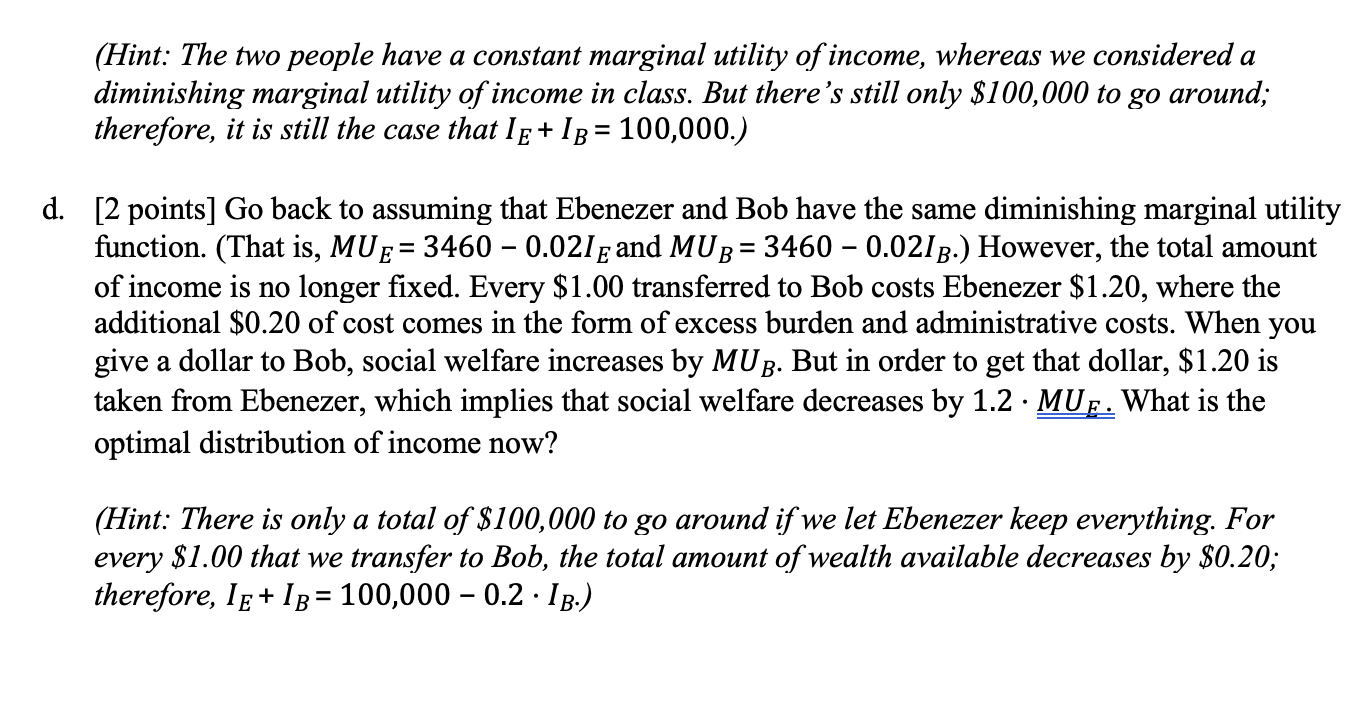
Please help with the question below. Thank you.
6) [8 points total] In class we analyzed the optimal income distribution under four important assumptions: i. Social welfare is strictly/additively utilitarian. ii. Individuals have identical utility functions that depend only on income. iii. The marginal utility of income diminishes with income. iv. The total amount of income is xed. Under those assumptions, it is socially optimal to transfer income from the rich to the poor until perfect income equality is achieved. In this problem you will assess how the socially optimal income distribution changes when you relax each of those assumptions. Consider a society with two people, Ebenezer and Bob. Social welfare is given by: W = UE + U3 5 where U Eis Ebenezer's utility and U B is Bob's utility. They have identical utility functions, where the marginal of utility of income diminishes with income: MUE= 3460 0-021E and MUB= 3460 0.0213, where I E is Ebenezer's income and I B is Bob's income. Finally, Ebenezer is endowed with $100,000 of wealth, whereas Bob has $0. Under the four assumptions listed above, half of Ebenezer's wealth should be taxed and transferred to Bob so that each has $50,000 of income. a. [2 points] Suppose that social welfare is not stlictly utilitarian. Ebenezer is kind of a jerk, so society places twice as much weight on Bob's utility: W = U E + 2 - U B. When you take a dollar from Ebenezer, social welfare decreases by But when you give that dollar to Bob, social welfare increases by 2 - M U B. What is the optimal distribution of income now? (Hint: The social welfare mction has changed from what we considered in class. But there 's still only $100,000 to go around; therefore, it is still the case that IE + I B = 100,000.) b. [2 points] Go back to assuming that social welfare is strictly utilitarian. However, Ebenezer likes money more than Bob. Ebenezer's marginal utility of income is still M U E = 34-60 0.021'E, but Bob's is lower and given by M U B = 2860 0.0213. What is the optimal distribution of income now? (Hint: Unlike the example in class, the two people have dierent marginal utility functions. But there is still only $100,000 to go around; therefore, it is still the case that I E + I B = 100,000.) c. [2 points] Go back to assuming that Ebenezer and Bob have the same utility mctions. However, both have a constant marginal utility of income given by M U E = M U B = 3460. What is the optimal distribution of income now? (Hint: The two people have a constant marginal utility of income, whereas we considered a diminishing marginal utility of income in class. But there 's still only $100, 000 to go around; therefore, it is still the case that [E + [B = 100,000.) [2 points] Go back to assuming that Ebenezer and Bob have the same diminishing marginal utility function. (That is, M U E = 3460 0.0213 and M U B = 3460 0.0213.) However, the total amount of income is no longer xed. Every $1.00 transferred to Bob costs Ebenezer $1.20, where the additional $0.20 of cost comes in the form of excess burden and administrative costs. When you give a dollar to Bob, social welfare increases by M U 3. But in order to get that dollar, $1.20 is taken from Ebenezer, which implies that social welfare decreases by 1.2 - M What is the optimal distribution of income now? (Hint: There is only a total of $1 00, 000 to go around if we let Ebenezer keep everything. For every $1.00 that we transfer to Bob, the total amount of wealth available decreases by $0.20; therefore, 15+ lg = 100,000 0.2 - 13.)









